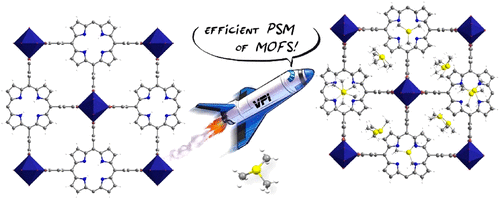当前位置:
X-MOL 学术
›
Inorg. Chem.
›
论文详情
Our official English website, www.x-mol.net, welcomes your
feedback! (Note: you will need to create a separate account there.)
Vapor-Phase Infiltration inside a Microporous Porphyrinic Metal-Organic Framework for Postsynthesis Modification.
Inorganic Chemistry ( IF 4.3 ) Pub Date : 2020-07-06 , DOI: 10.1021/acs.inorgchem.0c01250 Siddhartha De 1 , Gia Co Quan 1 , Ben Gikonyo 1 , Charlotte Martineau-Corcos 2, 3 , Colin Bousige 1 , Laurent Veyre 4 , Thomas Devic 5 , Catherine Marichy 1 , Alexandra Fateeva 1
Inorganic Chemistry ( IF 4.3 ) Pub Date : 2020-07-06 , DOI: 10.1021/acs.inorgchem.0c01250 Siddhartha De 1 , Gia Co Quan 1 , Ben Gikonyo 1 , Charlotte Martineau-Corcos 2, 3 , Colin Bousige 1 , Laurent Veyre 4 , Thomas Devic 5 , Catherine Marichy 1 , Alexandra Fateeva 1
Affiliation

|
Vapor-phase infiltration (VPI), a technique derived from atomic layer deposition (ALD) and based on sequential self-limiting chemistry, is used to modify the stable microporous porphyrin-based metal–organic framework (MOF) MIL-173(Zr). VPI is an appealing approach to modifying MOFs by inserting reactants with atomic precision. The microporous nature and chemical stability of MIL-173 enable postsynthesis modification by VPI without MOF degradation even with extremely reactive precursors such as trimethylaluminum (TMA) and diethylzinc (DEZ). VPI proceeds through the diffusion of gaseous organometallic reactants TMA and DEZ inside the microporous framework, where they react with two kinds of chemical sites offered by the porphyrinic linker (phenolic and pyrrolic functions in the porphyrin core), without altering the crystallinity and permanent porosity of the MOF. 27Al NMR, UV–vis absorption, and IR spectroscopies are used to further characterize the modified material. Physisorption of both precursors is computationally simulated by grand canonical Monte Carlo methods and outlines the preferential adsorption sites. The impact of temperature, number of VPI cycles, and pulse length are investigated and show that aluminum and zinc are introduced in a saturating manner inside the MOF on both available reactive sites. The porosity prerequisite is outlined for VPI, which is proven to be much more effective than classical solution-based methods because it is solventless and fast, prevents workup steps, and allows reactions not possible by the classical solution approach.
中文翻译:

微孔卟啉金属有机骨架内部的气相渗透,用于后合成修饰。
气相渗透(VPI)是一项基于原子层沉积(ALD)的技术,它基于顺序自限化学,用于修饰稳定的基于微孔卟啉的金属-有机骨架(MOF)MIL-173(Zr) 。VPI是通过以原子精度插入反应物来修改MOF的有吸引力的方法。MIL-173的微孔性质和化学稳定性能够通过VPI进行合成后修饰,而不会发生MOF降解,即使是具有极活泼性的前体,例如三甲基铝(TMA)和二乙基锌(DEZ)。VPI通过微孔骨架中气态有机金属反应物TMA和DEZ的扩散而进行,它们在其中与卟啉连接子提供的两种化学位点发生反应(卟啉核心中的酚和吡咯官能团),27 Al NMR,UV-vis吸收和IR光谱用于进一步表征改性材料。两种前体的物理吸附均通过经典的蒙特卡洛方法进行了计算模拟,并概述了优先吸附位。研究了温度,VPI循环次数和脉冲长度的影响,结果表明铝和锌以饱和方式引入到两个可用的反应位点上的MOF中。概述了VPI的孔隙率先决条件,事实证明它比传统的基于溶液的方法要有效得多,因为它无溶剂且快速,可防止后处理步骤并允许经典解决方案无法进行反应。
更新日期:2020-07-20
中文翻译:

微孔卟啉金属有机骨架内部的气相渗透,用于后合成修饰。
气相渗透(VPI)是一项基于原子层沉积(ALD)的技术,它基于顺序自限化学,用于修饰稳定的基于微孔卟啉的金属-有机骨架(MOF)MIL-173(Zr) 。VPI是通过以原子精度插入反应物来修改MOF的有吸引力的方法。MIL-173的微孔性质和化学稳定性能够通过VPI进行合成后修饰,而不会发生MOF降解,即使是具有极活泼性的前体,例如三甲基铝(TMA)和二乙基锌(DEZ)。VPI通过微孔骨架中气态有机金属反应物TMA和DEZ的扩散而进行,它们在其中与卟啉连接子提供的两种化学位点发生反应(卟啉核心中的酚和吡咯官能团),27 Al NMR,UV-vis吸收和IR光谱用于进一步表征改性材料。两种前体的物理吸附均通过经典的蒙特卡洛方法进行了计算模拟,并概述了优先吸附位。研究了温度,VPI循环次数和脉冲长度的影响,结果表明铝和锌以饱和方式引入到两个可用的反应位点上的MOF中。概述了VPI的孔隙率先决条件,事实证明它比传统的基于溶液的方法要有效得多,因为它无溶剂且快速,可防止后处理步骤并允许经典解决方案无法进行反应。











































 京公网安备 11010802027423号
京公网安备 11010802027423号